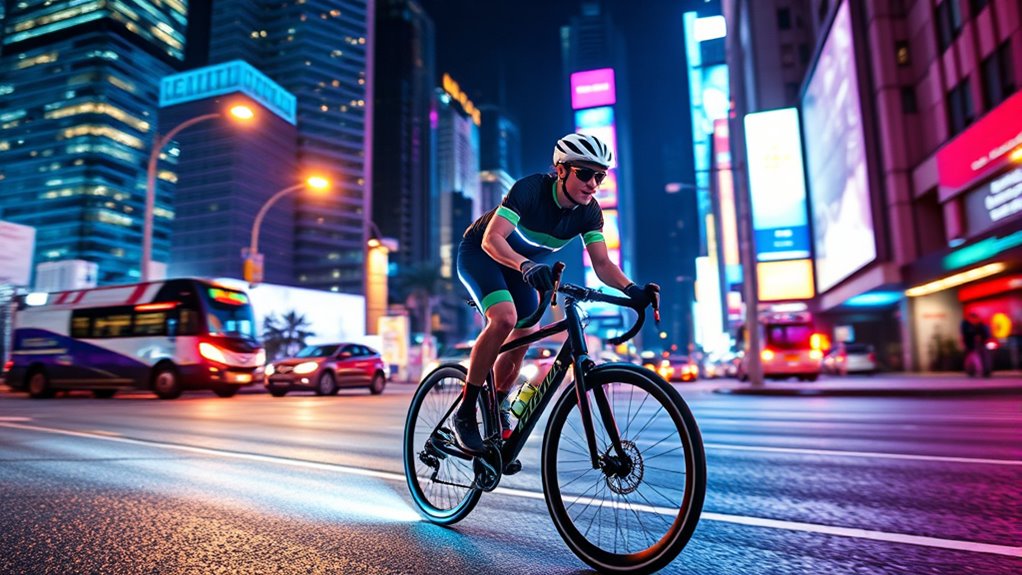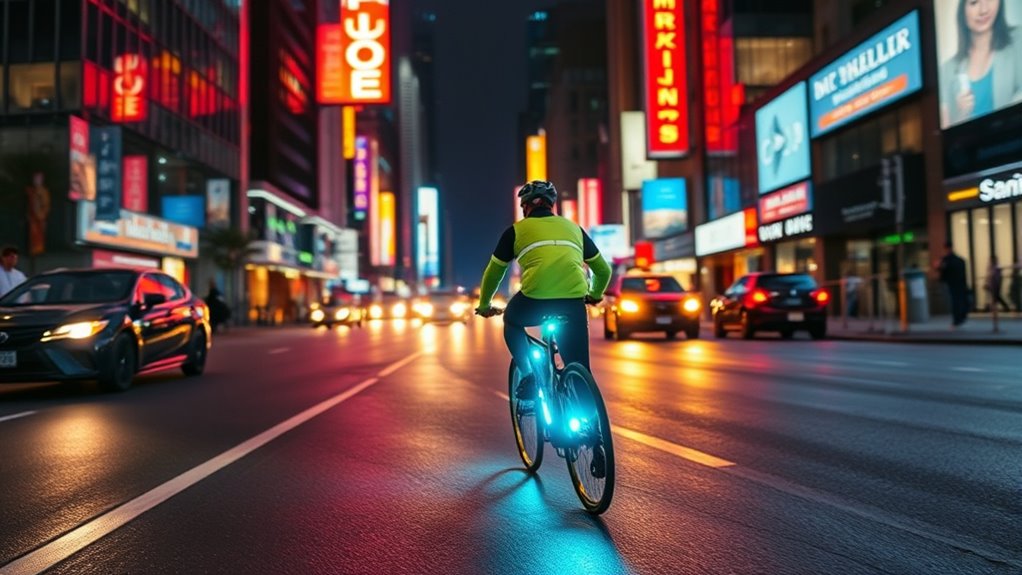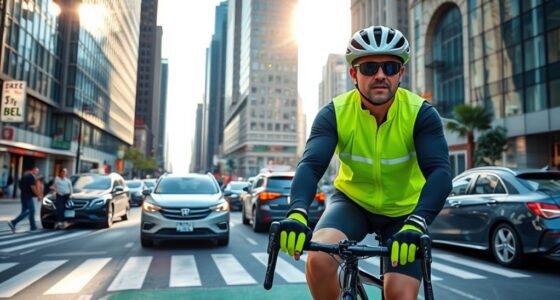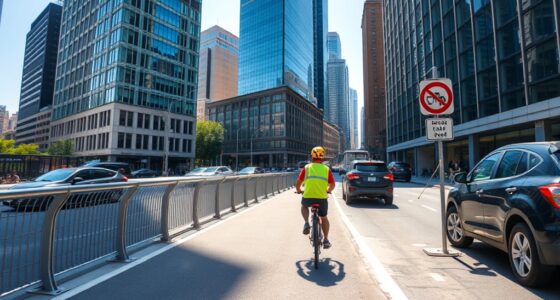To stay safe and visible when night riding in the city, make sure you have bright front and rear lights and add reflective tape or clothing. Keep scanning ahead for obstacles and signal your moves clearly to pedestrians and drivers. Ride at a moderate speed for better control and always check your lights beforehand. Being proactive about visibility and communication helps prevent accidents. Continue exploring ways to ride confidently even after dark.
Key Takeaways
- Equip your bike with high-quality front and rear lights, and add reflective tape or stickers for increased visibility.
- Wear reflective clothing and accessories, especially on ankles, wrists, and helmet, to attract driver attention.
- Ride at a moderate speed, use smooth brakes, and adjust your pace based on visibility and road conditions.
- Plan routes avoiding poorly lit areas and familiarize yourself with the route during daylight for better navigation.
- Use signals and a horn or bell to communicate with pedestrians and other cyclists, ensuring clear awareness of your intentions.

Night riding in the city offers a unique blend of tranquility and excitement that daytime cannot match. As the streets quiet down and lights flicker on, you get a different perspective of your surroundings. The hustle and bustle fade into a calm background, allowing you to focus more on your ride and the city’s subtle details. But while the atmosphere shifts, safety and visibility become even more important. Darkness can obscure hazards, making it essential to take extra precautions to protect yourself.
First, you need to prioritize being seen. Invest in high-quality front and rear lights for your bike, and consider adding reflective tape or stickers to your frame. Bright, flashing lights draw attention from drivers and pedestrians alike, reducing the risk of accidents. Wear reflective clothing or accessories, especially on your ankles, wrists, and helmet. The more visible you are, the safer you’ll be. Keep in mind that streetlights may be uneven or sparse in some areas, so relying solely on ambient lighting isn’t enough.
Prioritize visibility with bright lights, reflective gear, and caution in poorly lit areas for safer night riding.
Next, stay alert to your environment. Darkness makes it harder to spot obstacles, potholes, or debris on the road. Keep your eyes scanning ahead and use your peripheral vision to catch movement or unexpected hazards. Avoid distractions like listening to music at high volume or staring at your phone while riding. Your focus should be on the road, pedestrians, cars, and any potential changes in terrain. If you’re riding in unfamiliar parts of the city, slow down and familiarize yourself with the route beforehand. Planning your ride during daylight hours can help you identify tricky turns, one-way streets, or construction zones that might be harder to see at night.
Speed also matters. Riding at a moderate pace gives you more control and reaction time if something suddenly appears in your path. It’s tempting to push your limits in the cool night air, but rushing increases your chances of accidents. Use both brakes smoothly and gradually to avoid skidding, especially on wet or uneven surfaces common at night. Remember, the reduced visibility means you need to give yourself a little extra space to stop safely.
Finally, communicate your presence. Use your bike’s bell or horn when approaching pedestrians or other cyclists. Signal your intentions to turn or stop well in advance. This proactive approach helps prevent misunderstandings and ensures everyone stays safe. Night riding can be a rewarding experience if you stay vigilant and prepared. With the right gear, awareness, and caution, you’ll enjoy the city’s nighttime scenery while keeping yourself safe and visible after dark.
Frequently Asked Questions
What Are the Best Reflective Gear Options for Night Riders?
You want to stay safe and visible, so choosing the right reflective gear is key. Consider wearing reflective vests or straps that wrap around your body or bike, making you highly noticeable. LED lights are also effective, especially rear and front lights that flash or stay steady. Reflective tape on your helmet, shoes, or clothing enhances visibility. Combining multiple options ensures you’re seen from all angles, keeping you safe during night rides.
How Can I Improve My Visibility to Drivers at Night?
Think of yourself as a lighthouse guiding ships safely home. To improve your visibility to drivers at night, wear bright, reflective clothing and accessories that catch every beam of headlights. Use front and rear lights on your bike, and consider adding reflective tape to your gear. Stay predictable with your movements, and make eye contact with drivers when possible. These steps will help you stand out like a beacon in the dark, ensuring safety.
Are There Specific Routes Safer for Night Riding?
You should choose routes with good lighting and less traffic to stay safer while riding at night. Avoid dark alleys or poorly lit streets where drivers might not see you. Look for bike lanes or paths specifically designed for cyclists, as they tend to be safer. Planning your route ahead of time helps you stay on well-traveled, visible roads, reducing the risk of accidents or encounters with hazards.
What Should I Do if I Encounter Poor Street Lighting?
If you encounter poor street lighting, you should slow down to increase your reaction time and stay alert for obstacles or pedestrians. Use your bike’s lights and reflectors to improve visibility, and consider wearing bright or reflective clothing. Avoid dark, poorly lit areas whenever possible, and stick to well-lit routes. If necessary, dismount and walk your bike through the darker sections for added safety.
How Can I Stay Alert and Avoid Fatigue During Night Rides?
You stay alert and avoid fatigue during night rides by staying focused, staying hydrated, and taking regular breaks. Keep your mind sharp by listening to energizing music or engaging in mental checks. Maintain your physical alertness through deep breaths and stretching. Visualize your route, stay aware of your surroundings, and keep your eyes moving. By staying attentive, hydrated, and rested, you can ride safely and confidently through the night.
Conclusion
As the city lights flicker on and the night deepens, your ride becomes a dance between shadows and visibility. Staying alert and visible transforms potential dangers into moments of confidence. Just like the contrast of darkness and brightness, your careful preparations create a safe passage through the city’s nocturnal rhythm. Embrace the night with awareness, knowing that your vigilance is the brightest light guiding you home. Ride safe, and let the city’s glow be your shield.









